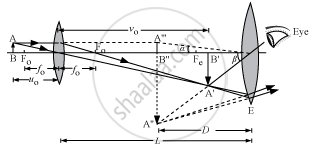Advertisements
Advertisements
Question
A compound microscope has an objective of focal length 1.25 cm and eyepiece of focal length 5 cm. A small object is kept at 2.5 cm from the objective. If the final image formed is at infinity, find the distance between the objective and the eyepiece ?
Solution

Distance between the objective and the eyepiece, L =
\[u_0 = - 2 . 5 \text {cm and } f_0 = 1 . 25 cm\]
\[\text { Now }, - \frac{1}{u_0} + \frac{1}{v_0} = \frac{1}{f_0}\] \[or \ v_0 = 2 . 5 cm\]
To find ue, we have:
\[v_e = \infty\text { and } f_e = 5 cm\]
Calculating using the same formula as above, we get:
RELATED QUESTIONS
Magnifying power of a simple microscope is inversely proportional to the focal length of the lens. What then stops us from using a convex lens of smaller and smaller focal length and achieving greater and greater magnifying power?
Why must both the objective and the eyepiece of a compound microscope have short focal lengths?
How can the resolving power of a compound microscope be increased? Use relevant formula to support your answer.
Draw the labelled ray diagram for the formation of image by a compound microscope.
Derive the expression for the total magnification of a compound microscope. Explain why both the objective and the eyepiece of a compound microscope must have short focal lengths.
The separation between the objective and the eyepiece of a compound microscope can be adjusted between 9.8 cm to 11.8 cm. If the focal lengths of the objective and the eyepiece are 1.0 cm and 6 cm respectively, find the range of the magnifying power if the image is always needed at 24 cm from the eye
Define the magnifying power of a microscope in terms of visual angle.
A convex lens of a focal length 5 cm is used as a simple microscope. Where should an object be placed so that the image formed by it lies at the least distance of distinct vision (D = 25 cm)?
Draw a labelled ray diagram showing the formation of image by a compound microscope in normal adjustment. Derive the expression for its magnifying power.
The near vision of an average person is 25 cm. To view an object with an angular magnification of 10, what should be the power of the microscope?
| A compound microscope consists of two converging lenses. One of them, of smaller aperture and smaller focal length, is called objective and the other of slightly larger aperture and slightly larger focal length is called eye-piece. Both lenses are fitted in a tube with an arrangement to vary the distance between them. A tiny object is placed in front of the objective at a distance slightly greater than its focal length. The objective produces the image of the object which acts as an object for the eye-piece. The eye-piece, in turn, produces the final magnified image. |
Which of the following is not correct in the context of a compound microscope?
